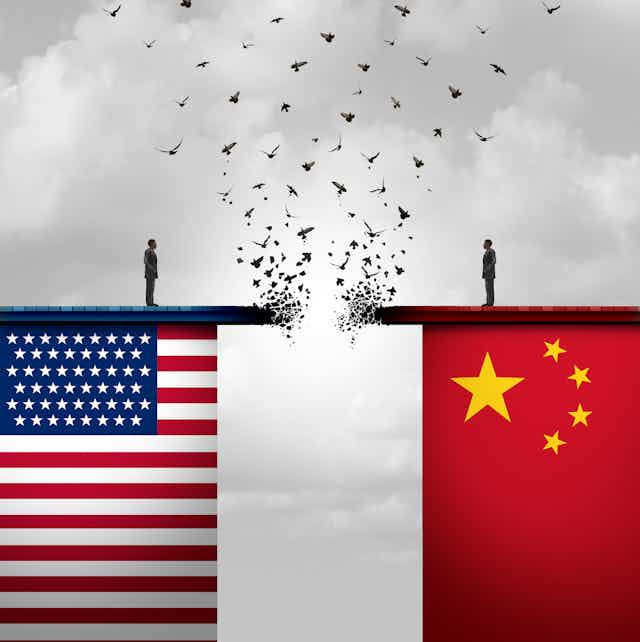During an official visit to Australia in 2016, US President Joe Biden assured America’s Pacific allies that “We’re not trying to contain China”. That assurance is looking very shaky now.
The Biden administration’s energetic promotion of the Quad grouping and the AUKUS alliance convey a message that few observers have difficulty interpreting. Defence Secretary Lloyd Austin has been particularly clear, speaking of mobilising “all tools of national power” to create “guardrails” to block China from displacing America from its global leadership role.
As Financial Times editor Edward Luce observes, containing China is now Biden’s explicit goal.
The Cold War mantra
What exactly is meant by “containing”? We seldom talk about “containing” France, Britain or the United States, for instance. In the imagery of containment, “they” are always unruly and liable to overstep their boundaries. Meanwhile, “we” are always the sedentary targets of that expansionism.
If the US is to contain China, it must lead a global alliance committed to the same goal. This is evidently what the US hopes to do. This aspiration is making many of its allies increasingly uncomfortable.
“Containment” was the great Cold War mantra. Its origins can be traced to American diplomat George F. Kennan, whose 1946 “long telegram” to the State Department called on the US government to develop a strategy for preventing the spread of the “malignant parasite” of Soviet communism.
In an anonymous 1947 article in the journal Foreign Affairs, he labelled this strategy as “containment”, and stressed that Soviet expansionism had deep roots in the “Russian-Asiatic” psyche.
This did not deter US policymakers from applying his containment strategy – with even greater enthusiasm – to China following the 1949 establishment of the People’s Republic in Beijing.
As geographer Charles Fisher pointed out in the early 1970s, the idea of “containing China” echoed much older European and US images of the world. Fisher highlighted the influence of 19th and early 20th century civilisation theorist Halford Mackinder, whose thesis on “the geographical pivot of history” played “a seminal part in the development of the containment doctrine”.
European civilisation was seen as “the outcome of the secular struggle against Asiatic invasion” embodied in the invasions of the “Mongol hordes which fell upon Europe in the 14th century”. The rise of steam power and the railways had created the prospect of the emergence of a new landlocked Eurasian power that would challenge western civilisation.

Widespread public acceptance of Cold War containment policy towards China, Fisher argued, stemmed partly from its resonance with older, western images of the world.
[…] in the 1950s, it seemed that a single vast Eurasian Communist bloc now stretched like the old Mongol empire from the plains of eastern Europe to the shores of the China Sea, there to confront the United States across a rapidly shrinking Pacific Ocean.
With the rise of powerful revolutionary movements in Southeast Asia, American foreign policy became haunted by the vision of the “virus of communism” spreading from China across Asia. China became the chief object of US containment. In the words of journalist Don Oberdorfer, Vietnam became “‘the place to draw the line’ against the communist tide and especially against the Chinese hordes seen as the most virulent and threatening manifestation of international Marxism”.

The Trump era rhetoric
The widespread revival of Cold War containment rhetoric began under US President Donald Trump. His trade advisor, Peter Navarro, wrote a series of books partly based on fabricated sources with lurid titles such as “Death By China: Confronting the Dragon”, resurrecting early 20th century stereotypes of the Chinese “hordes”.
The Biden administration has tried to refashion Trump’s crude China-bashing into a more refined containment policy. But the polite language of the strategy carries familiar undertones. China’s growing power is condensed into a simple image of a global bully “exporting the tools of autocracy abroad.”
The new buzzword of Biden’s China policy defines China as the United States’ “pacing challenge”. This term is rarely defined. It paints world politics as a two-horse power race in which China must never be allowed to get its nose in front of the US.
All of this is accompanied by repeated assurances from senior US officials that they are “not looking for conflict”. But these assurances are not the same thing as a concerted diplomatic effort to find creative approaches to the current crisis in relations. A key problem with the Biden administration’s containment strategy is that it conflates urgently needed international cooperation to protect security and freedom with the “pacing challenge” of keeping the US one step ahead of China.
This strategy therefore risks becoming, like the Cold War version of containment, a perpetual struggle for the preservation of the status quo. As Henry Kissinger once observed, that allows “no role for diplomacy”.
Within the Biden administration, there are clearly divided views about the way this new version of containment is taking shape. Among close allies of the US, there seems no desire for it.
As Indonesian Foreign Minister Retno Marsudi said:
Rather than being a pawn in this new Cold War, we must promote principles and values enshrined in ASEAN’s outlook on the Indo-Pacific region to guide other countries in their engagement with our region.
There could be nothing more urgent than searching for alternatives to a retreat into the mindset of Cold War containment policy, with all its haunting traces of past fears and violence, and all its potential to spiral into disastrous future conflicts.

